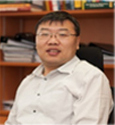题目:Symmetry Breaking by Materials Engineering for Spin-Orbit-Torque Technology
报告人:Porf. Chen Jingsheng
National University of Singapore (NUS)
Senior Member, IEEE MAGNETICS
研究方向:Spintronics, Multiferroics, Ferroelectrics
报告时间:2023年10月24日(周二),上午9:30
报告地点:李薰楼468会议室
 个人简介:
个人简介:
Jingsheng Chen is Professor and Deputy Head in Department of Materials Science and Engineering, NUS. He obtained his Ph.D degree in 1999 in Lanzhou University, China and joined NUS in December 2007. During 2001-2007 he worked at the Data Storage Institute as a research scientist. He has authored/co-authored more than 300 refereed journal papers including Nature, Nature Nanotechnology, Nature Comm. Science Advance, Advanced Materials, Physical Review X, Physical Review Letter etc., 3 book chapters, holds over ten patents and has made more than 100 invited presentation in the international conferences. His research work has obtained more than 13000 citations with H index of 60. His research interest includes magnetic and oxide based non-volatile memories, spintronics, ferroelectric tunnel junction, strongly correlated oxide materials. He secured more than S$17 million research grants from government and around US$ 1 million from Seagate Technology and more than S$ 1 million from Globalfoundries. The magnetic recording media in the newest generation of HDD (HAMR) applied a few of his inventions. He is 2022 IEEE Magnetic Society Distinguished Lecturer.
报告内容:
Electric manipulation of magnetization is essential for the integration of magnetic functionalities in integrated circuits. Spin-orbit torque (SOT), originating from the coupling of electron spin and orbital motion through spin-orbital interaction, is able to effectively manipulate magnetization. Symmetry breaking plays an important role in spintronics based on SOT. SOT requires inversion asymmetry in order to have a net effect on magnetic materials, which is commonly realized by spatial asymmetry: a thin magnetic layer sandwiched between two dissimilar layers. This kind of structure restricts the SOT by mirror and rotational symmetries to have a particular form: an “antidamping-like” component oriented in the film plane even upon reversal of the magnetization direction. Consequently, magnetization perpendicular to the film plane cannot be deterministically switched with pure electric current. To achieve all-electric switching of perpendicular magnetization, it is necessary to break the mirror and rotational symmetries of the sandwiched structure.
In this lecture, I will begin with a basic introduction of the physical origin of SOT, followed by the related symmetry analysis of a magnetic thin film in a sandwiched structure for the generation of a net SOT effect. Then I will introduce a new method a composition gradient along the thin-film normal for breaking the inversion symmetry
a composition gradient along the thin-film normal for breaking the inversion symmetry to generate bulk-like SOT, which enables a thicker magnetic layer with high magnetic anisotropy. An overview of the methods commonly used to break mirror and rotational symmetries in order to realize all-electric switching of perpendicular magnetization will follow. I will give a detailed discussion on our methods for the realization of all-electric switching of perpendicular magnetization: the use of a spin source layer with low magnetic symmetry and low crystal symmetry, which generates an out-of-plane SOT ; interfacial 3m1 symmetry, which induces a new “3m” spin torque; precise control of the tilting of magnetocrystalline anisotropy easy axis; and a spin-current gradient along the current direction.
to generate bulk-like SOT, which enables a thicker magnetic layer with high magnetic anisotropy. An overview of the methods commonly used to break mirror and rotational symmetries in order to realize all-electric switching of perpendicular magnetization will follow. I will give a detailed discussion on our methods for the realization of all-electric switching of perpendicular magnetization: the use of a spin source layer with low magnetic symmetry and low crystal symmetry, which generates an out-of-plane SOT ; interfacial 3m1 symmetry, which induces a new “3m” spin torque; precise control of the tilting of magnetocrystalline anisotropy easy axis; and a spin-current gradient along the current direction.
热诚欢迎大家参加!



